The Cambridge History of China. Vol. 06. Alien Regimes and Border States, 907-1368
Подождите немного. Документ загружается.

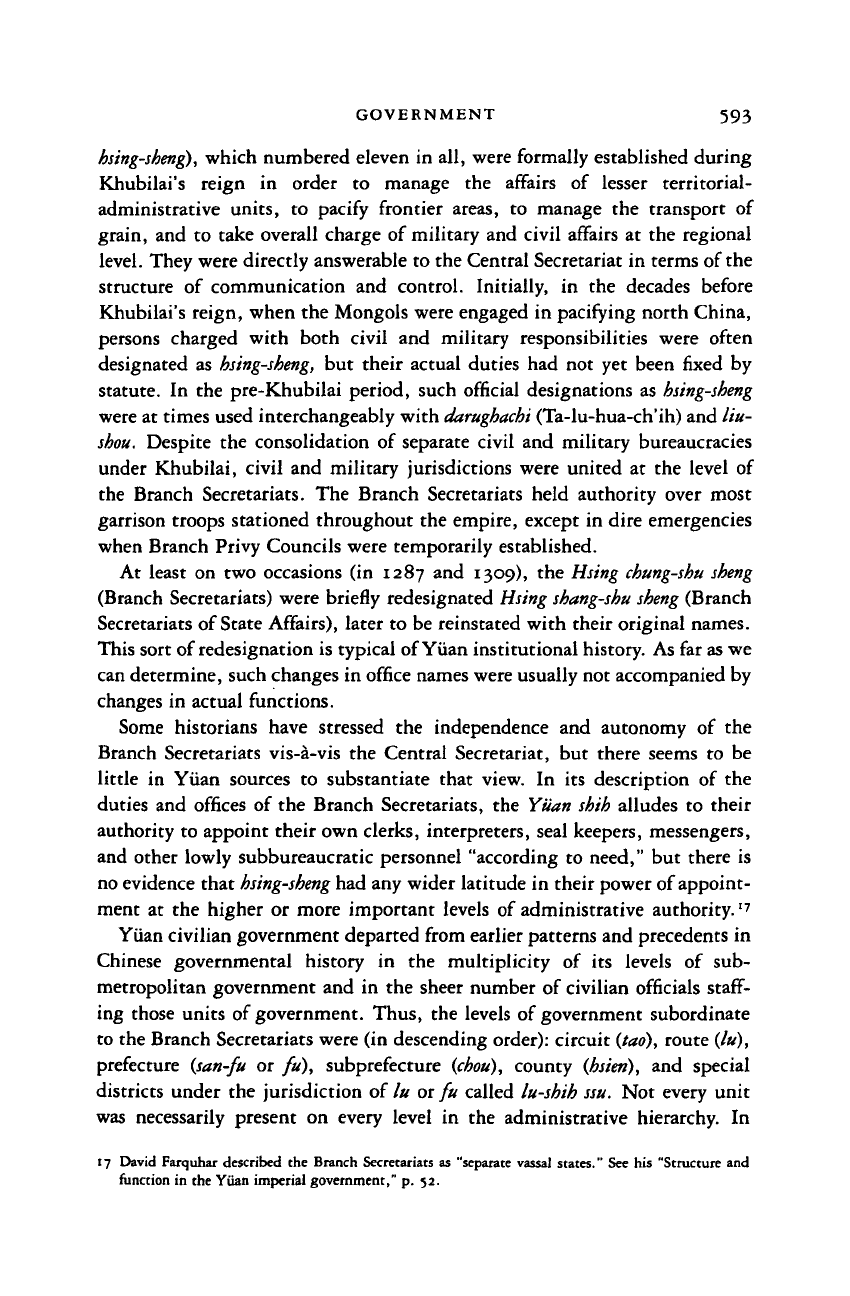
GOVERNMENT 593
hsing-sheng),
which numbered eleven in all, were formally established during
Khubilai's reign in order to manage the affairs of lesser territorial-
administrative units, to pacify frontier areas, to manage the transport of
grain, and to take overall charge of military and civil affairs at the regional
level. They were directly answerable to the Central Secretariat in terms of the
structure of communication and control. Initially, in the decades before
Khubilai's reign, when the Mongols were engaged in pacifying north China,
persons charged with both civil and military responsibilities were often
designated as
hsing-sbeng,
but their actual duties had not yet been fixed by
statute. In the pre-Khubilai period, such official designations as
hsing-sheng
were at times used interchangeably with
darughachi
(Ta-lu-hua-ch'ih) and liu-
shou. Despite the consolidation of separate civil and military bureaucracies
under Khubilai, civil and military jurisdictions were united at the level of
the Branch Secretariats. The Branch Secretariats held authority over most
garrison troops stationed throughout the empire, except in dire emergencies
when Branch Privy Councils were temporarily established.
At least on two occasions (in 1287 and 1309), the Hsing
chung-shu sheng
(Branch Secretariats) were briefly redesignated Hsing
shang-shu sheng
(Branch
Secretariats of State Affairs), later to be reinstated with their original names.
This sort of redesignation is typical of Yiian institutional history. As far as we
can determine, such changes in office names were usually not accompanied by
changes in actual functions.
Some historians have stressed the independence and autonomy of the
Branch Secretariats vis-a-vis the Central Secretariat, but there seems to be
little in Yiian sources to substantiate that view. In its description of the
duties and offices of the Branch Secretariats, the Yiian shih alludes to their
authority to appoint their own clerks, interpreters, seal keepers, messengers,
and other lowly subbureaucratic personnel "according to need," but there is
no evidence that
hsing-sheng
had any wider latitude in their power of appoint-
ment at the higher or more important levels of administrative authority. '
7
Yiian civilian government departed from earlier patterns and precedents in
Chinese governmental history in the multiplicity of its levels of sub-
metropolitan government and in the sheer number of civilian officials
staff-
ing those units of government. Thus, the levels of government subordinate
to the Branch Secretariats were (in descending order): circuit (tao), route (/»),
prefecture (san-fu or fu), subprefecture {chou), county (hsien), and special
districts under the jurisdiction of lu or fu called lu-shih ssu. Not every unit
was necessarily present on every level in the administrative hierarchy. In
17 David Farquhar described the Branch Secretariats as "separate vassal states." See his "Structure and
function in the Yiian imperial government," p. 52.
Cambridge Histories Online © Cambridge University Press, 2008
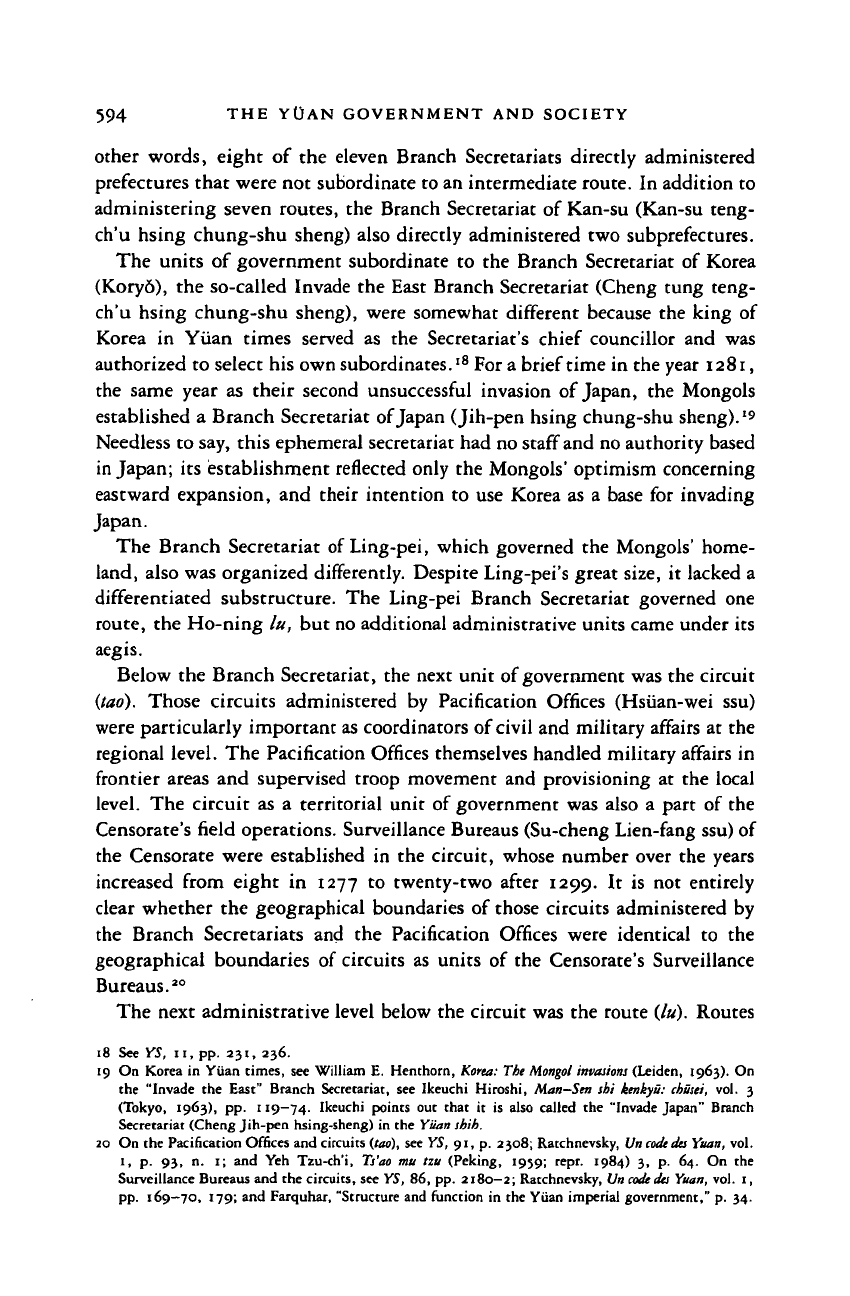
594
THE
YOAN GOVERNMENT AND SOCIETY
other words, eight of the eleven Branch Secretariats directly administered
prefectures that were not subordinate to an intermediate route. In addition to
administering seven routes, the Branch Secretariat of Kan-su (Kan-su teng-
ch'u hsing chung-shu sheng) also directly administered two subprefectures.
The units of government subordinate to the Branch Secretariat of Korea
(Kory6), the so-called Invade the East Branch Secretariat (Cheng tung teng-
ch'u hsing chung-shu sheng), were somewhat different because the king of
Korea in Yuan times served as the Secretariat's chief councillor and was
authorized to select his own subordinates.
18
For a brief time in the year 1281,
the same year as their second unsuccessful invasion of Japan, the Mongols
established a Branch Secretariat of Japan (Jih-pen hsing chung-shu sheng).'»
Needless to say, this ephemeral secretariat had no staff and no authority based
in
Japan; its establishment reflected only the Mongols' optimism concerning
eastward expansion, and their intention to use Korea as a base for invading
Japan.
The Branch Secretariat of Ling-pei, which governed the Mongols' home-
land, also was organized differently. Despite Ling-pei's great size, it lacked a
differentiated substructure. The Ling-pei Branch Secretariat governed one
route, the Ho-ning lu, but no additional administrative units came under its
aegis.
Below the Branch Secretariat, the next unit of government was the circuit
(fad).
Those circuits administered by Pacification Offices (Hsiian-wei ssu)
were particularly important as coordinators of
civil
and military affairs at the
regional level. The Pacification Offices themselves handled military affairs in
frontier areas and supervised troop movement and provisioning at the local
level. The circuit as a territorial unit of government was also a part of the
Censorate's field operations. Surveillance Bureaus (Su-cheng Lien-fang ssu) of
the Censorate were established in the circuit, whose number over the years
increased from eight in 1277 to twenty-two after 1299. It is not entirely
clear whether the geographical boundaries of those circuits administered by
the Branch Secretariats and the Pacification Offices were identical to the
geographical boundaries of circuits as units of the Censorate's Surveillance
Bureaus.
20
The next administrative level below the circuit was the route
(lu).
Routes
18 See YS, n, pp. 231, 236.
19 On Korea in Yuan times, see William £. Henthorn, Korea: The Mongol
invasions
(Leiden, 1963). On
the "Invade the East" Branch Secretariat, see Ikeuchi Hiroshi,
Man—Sen
sbi kenkyu:
chusei,
vol. 3
(Tokyo, 1963), pp. 119—74. Ikeuchi points out that it is also called the "Invade Japan" Branch
Secretariat (Cheng Jih-pen hsing-sheng) in the Yuan shih.
20 On the Pacification Offices and circuits (too), see YS, 91, p. 2308; Ratchnevsky, Un
coaedes
Yuan, vol.
i, p. 93, n. 1; and Yeh Tzu-ch'i, Ts'ao mu tzu (Peking, 1959; repr. 1984) 3, p. 64. On the
Surveillance Bureaus and the circuits, see YS, 86, pp. 2180-2; Ratchnevsky, Un
coaedes
Yuan, vol. 1,
pp.
169—70, 179; and Farquhar, "Structure and function in the Yuan imperial government," p. 34.
Cambridge Histories Online © Cambridge University Press, 2008
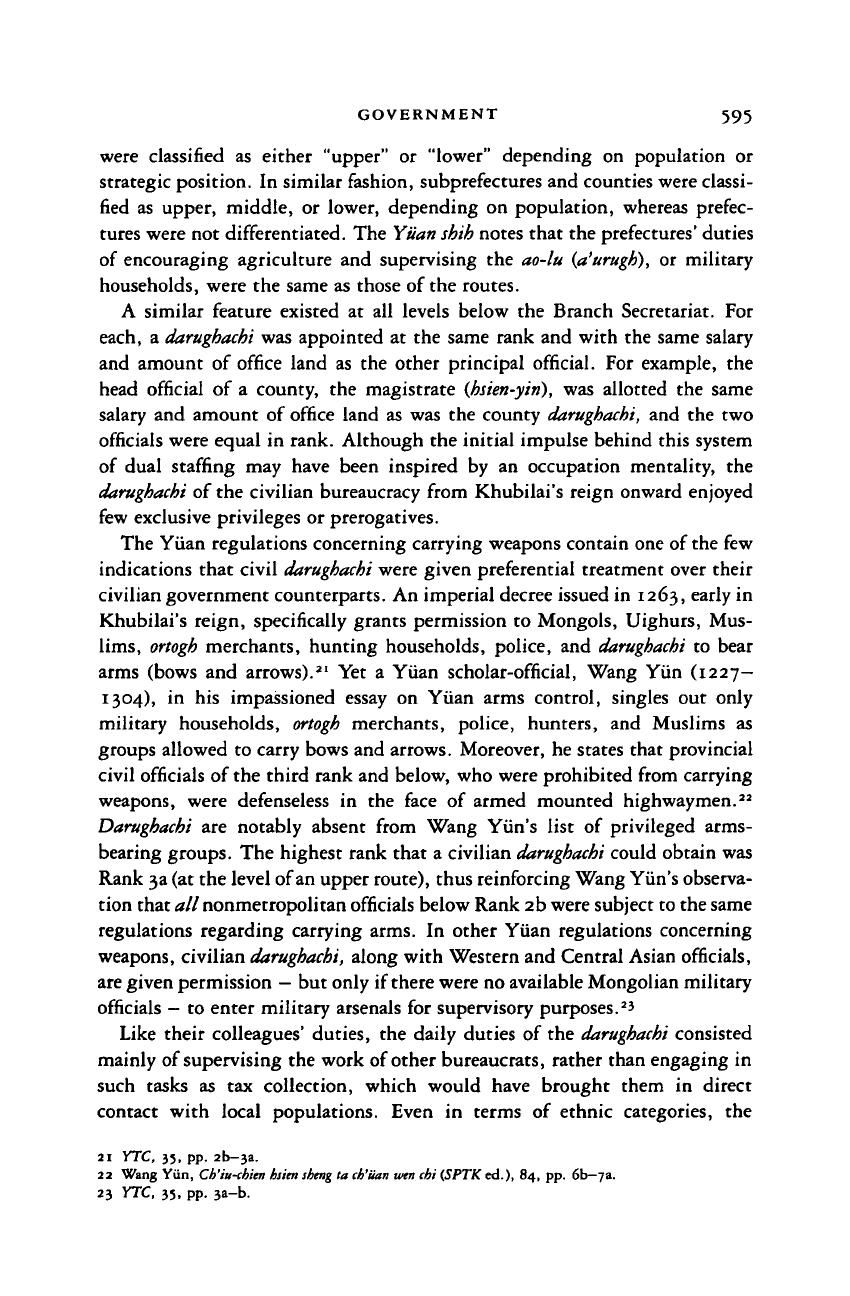
GOVERNMENT 595
were classified as either "upper" or "lower" depending on population or
strategic position. In similar fashion, subprefectures and counties were classi-
fied as upper, middle, or lower, depending on population, whereas prefec-
tures were not differentiated. The Yuan shih notes that the prefectures' duties
of encouraging agriculture and supervising the ao-lu (a'urugh), or military
households, were the same as those of the routes.
A similar feature existed at all levels below the Branch Secretariat. For
each, a darughachi was appointed at the same rank and with the same salary
and amount of office land as the other principal official. For example, the
head official of a county, the magistrate (hsien-yin), was allotted the same
salary and amount of office land as was the county darughachi, and the two
officials were equal in rank. Although the initial impulse behind this system
of dual staffing may have been inspired by an occupation mentality, the
darughachi of the civilian bureaucracy from Khubilai's reign onward enjoyed
few exclusive privileges or prerogatives.
The Yuan regulations concerning carrying weapons contain one of the few
indications that civil
darughachi
were given preferential treatment over their
civilian government counterparts. An imperial decree issued in 1263, early in
Khubilai's reign, specifically grants permission to Mongols, Uighurs, Mus-
lims,
ortogh
merchants, hunting households, police, and
darughachi
to bear
arms (bows and arrows).
21
Yet a Yuan scholar-official, Wang Yiin (1227—
1304),
in his impassioned essay on Yuan arms control, singles out only
military households, ortogh merchants, police, hunters, and Muslims as
groups allowed to carry bows and arrows. Moreover, he states that provincial
civil officials of the third rank and below, who were prohibited from carrying
weapons, were defenseless in the face of armed mounted highwaymen.
22
Darughachi are notably absent from Wang Yiin's list of privileged arms-
bearing groups. The highest rank that a civilian
darughachi
could obtain was
Rank 3a (at the level of an upper route), thus reinforcing Wang Yiin's observa-
tion that all nonmetropolitan officials below Rank 2b were subject to the same
regulations regarding carrying arms. In other Yuan regulations concerning
weapons, civilian
darughachi,
along with Western and Central Asian officials,
are given permission
—
but only if there were no available Mongolian military
officials - to enter military arsenals for supervisory purposes.
2
'
Like their colleagues' duties, the daily duties of the
darughachi
consisted
mainly of supervising the work of other bureaucrats, rather than engaging in
such tasks as tax collection, which would have brought them in direct
contact with local populations. Even in terms of ethnic categories, the
21 YTC, 35, pp. 2b—3a.
22 Wang Yiin, Ch'iu-chim
hsien sbeng
la
ch'iian
wen chi (SPTK ed.), 84, pp. 6b—7a.
23 YTC, 35, pp. 3a-b.
Cambridge Histories Online © Cambridge University Press, 2008
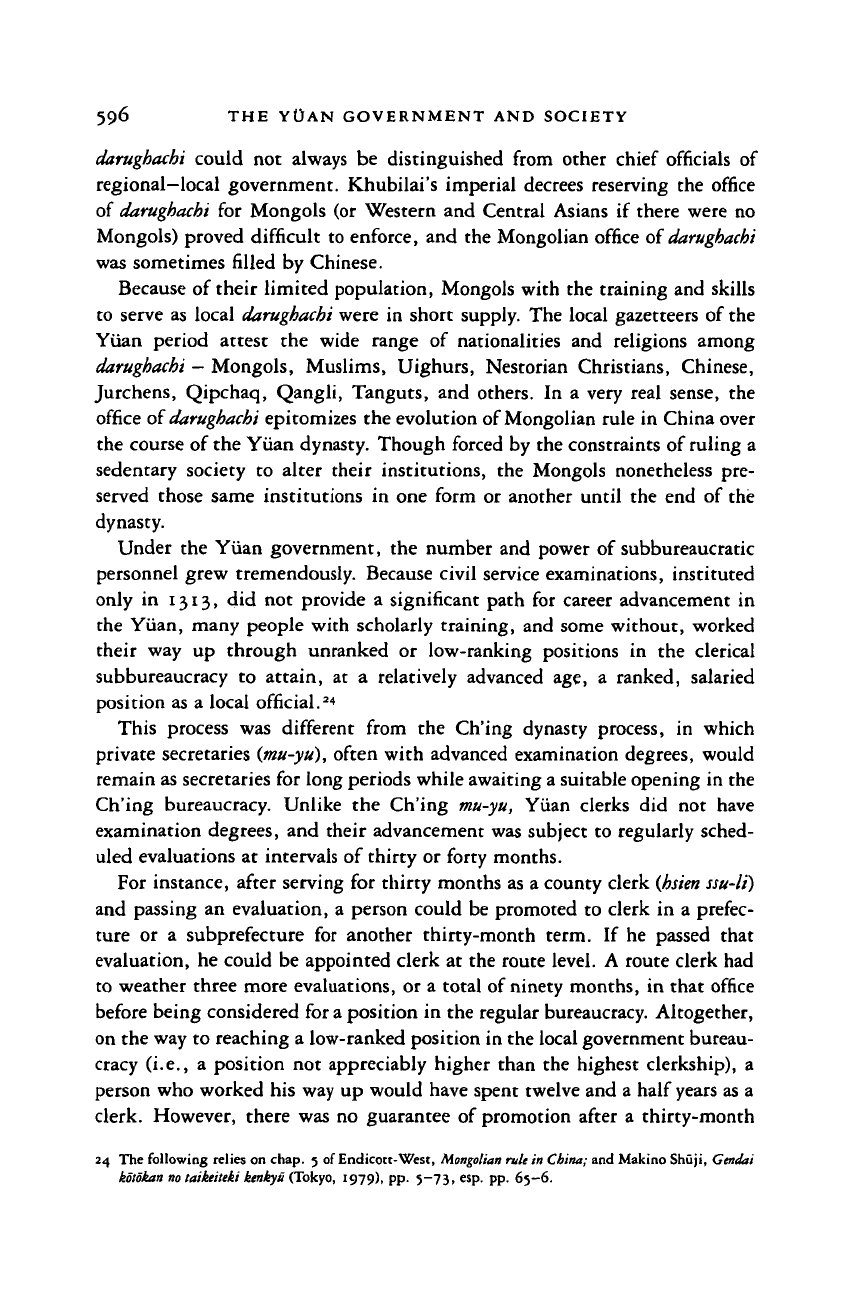
596 THE YOAN GOVERNMENT AND SOCIETY
darughachi
could not always be distinguished from other chief officials of
regional-local government. Khubilai's imperial decrees reserving the office
of
darughachi
for Mongols (or Western and Central Asians if there were no
Mongols) proved difficult to enforce, and the Mongolian office of
darughachi
was sometimes filled by Chinese.
Because of their limited population, Mongols with the training and skills
to serve as local
darughachi
were in short supply. The local gazetteers of the
Yuan period attest the wide range of nationalities and religions among
darughachi
- Mongols, Muslims, Uighurs, Nestorian Christians, Chinese,
Jurchens, Qipchaq, Qangli, Tanguts, and others. In a very real sense, the
office of
darughachi
epitomizes the evolution of Mongolian rule in China over
the course of the Yuan dynasty. Though forced by the constraints of ruling a
sedentary society to alter their institutions, the Mongols nonetheless pre-
served those same institutions in one form or another until the end of the
dynasty.
Under the Yuan government, the number and power of subbureaucratic
personnel grew tremendously. Because civil service examinations, instituted
only in 1313, did not provide a significant path for career advancement in
the Yuan, many people with scholarly training, and some without, worked
their way up through unranked or low-ranking positions in the clerical
subbureaucracy to attain, at a relatively advanced age, a ranked, salaried
position as a local official.
24
This process was different from the Ch'ing dynasty process, in which
private secretaries
(mu-yu),
often with advanced examination degrees, would
remain as secretaries for long periods while awaiting a suitable opening in the
Ch'ing bureaucracy. Unlike the Ch'ing mu-yu, Yuan clerks did not have
examination degrees, and their advancement was subject to regularly sched-
uled evaluations at intervals of thirty or forty months.
For instance, after serving for thirty months as a county clerk
(hsien ssu-li)
and passing an evaluation, a person could be promoted to clerk in a prefec-
ture or a subprefecture for another thirty-month term. If he passed that
evaluation, he could be appointed clerk at the route level. A route clerk had
to weather three more evaluations, or a total of ninety months, in that office
before being considered for
a
position in the regular bureaucracy. Altogether,
on the way to reaching a low-ranked position in the local government bureau-
cracy (i.e., a position not appreciably higher than the highest clerkship), a
person who worked his way up would have spent twelve and a half
years
as a
clerk. However, there was no guarantee of promotion after a thirty-month
24 The following relies on chap. 5 of Endicott-West, Mongolian rule in China; and Makino Shuji, Gendai
kotokan
no
taikeiuki kenkyu (Tokyo, 1979), pp. 5-73, esp. pp. 65-6.
Cambridge Histories Online © Cambridge University Press, 2008
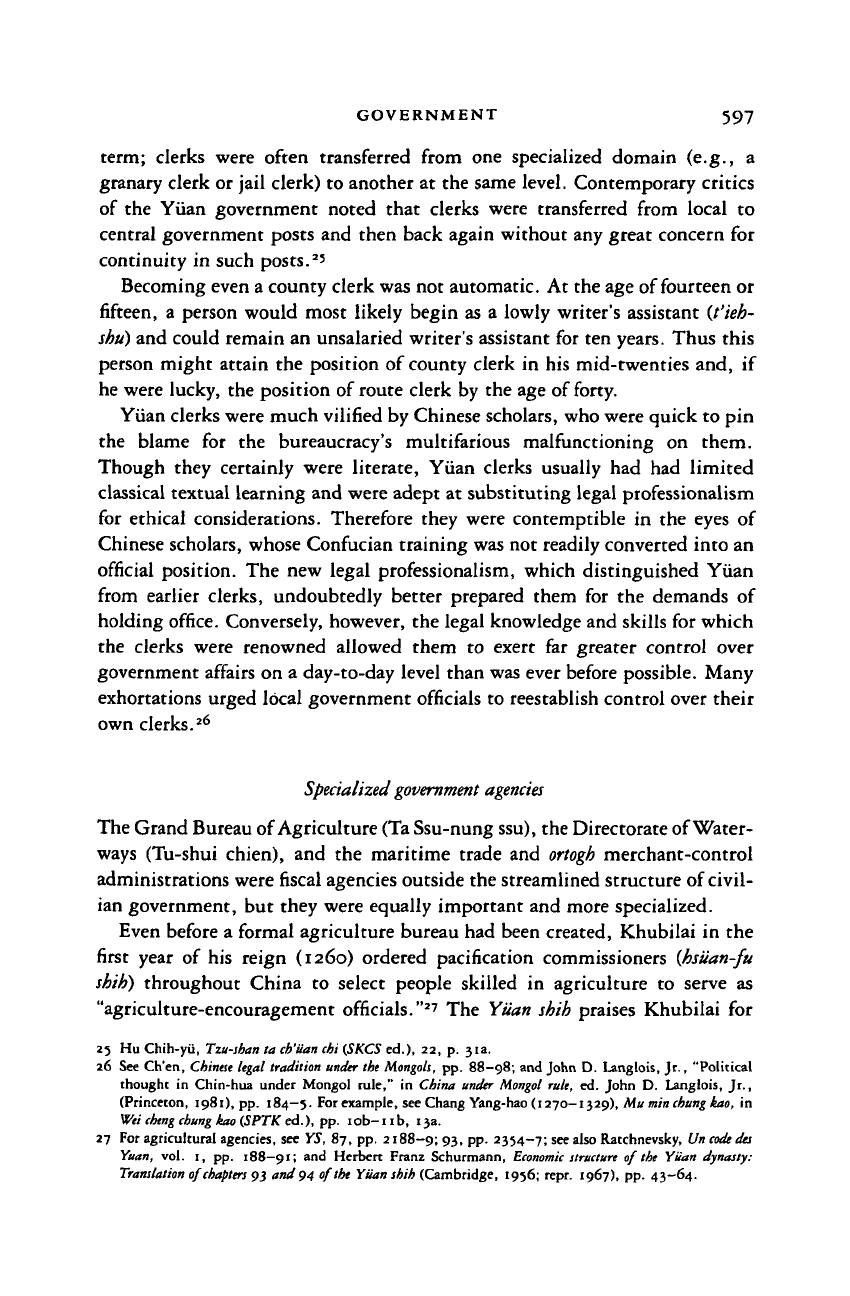
GOVERNMENT 597
term; clerks were often transferred from one specialized domain (e.g., a
granary clerk or jail clerk) to another at the same level. Contemporary critics
of the Yuan government noted that clerks were transferred from local to
central government posts and then back again without any great concern for
continuity in such posts.
2
'
Becoming even a county clerk was not automatic. At the age of fourteen or
fifteen, a person would most likely begin as a lowly writer's assistant (t'ieh-
shu) and could remain an unsalaried writer's assistant for ten years. Thus this
person might attain the position of county clerk in his mid-twenties and, if
he were lucky, the position of route clerk by the age of forty.
Yuan clerks were much vilified by Chinese scholars, who were quick to pin
the blame for the bureaucracy's multifarious malfunctioning on them.
Though they certainly were literate, Yuan clerks usually had had limited
classical textual learning and were adept at substituting legal professionalism
for ethical considerations. Therefore they were contemptible in the eyes of
Chinese scholars, whose Confucian training was not readily converted into an
official position. The new legal professionalism, which distinguished Yuan
from earlier clerks, undoubtedly better prepared them for the demands of
holding office. Conversely, however, the legal knowledge and skills for which
the clerks were renowned allowed them to exert far greater control over
government affairs on a day-to-day level than was ever before possible. Many
exhortations urged local government officials to reestablish control over their
own clerks.
26
Specialized government
agencies
The Grand Bureau of Agriculture (Ta Ssu-nung ssu), the Directorate of Water-
ways (Tu-shui chien), and the maritime trade and
ortogh
merchant-control
administrations were fiscal agencies outside the streamlined structure of civil-
ian government, but they were equally important and more specialized.
Even before a formal agriculture bureau had been created, Khubilai in the
first year of his reign (1260) ordered pacification commissioners {hsiian-fu
shihi) throughout China to select people skilled in agriculture to serve as
"agriculture-encouragement officials."
27
The Yuan shih praises Khubilai for
25 Hu Chih-yu, Tzu-shan ta cb'iian chi (SKCS ed.), 22, p. 31a.
26 See Ch'en,
Chinese
legal tradition under the Mongols, pp. 88-98; and John D. Langlois, Jr., "Political
thought in Chin-hua under Mongol rule," in China under Mongol rule, ed. John D. Langlois, Jr.,
(Princeton, 1981), pp. 184—5. For example, see Chang Yang-hao (1270-1329), Mu minchungkao, in
Wei cheng chung
kao 'SPTK ed.), pp. iob-nb, 13a.
27 For agricultural agencies, see YS, 87, pp. 2188-9; 93. PP- 2354-7; see also Ratchnevsky, Uncodedes
Yuan,
vol. 1, pp. 188—91; and Herbert Franz Schurmann,
Economic
structure of the Yuan dynasty:
Translation of
chapters
93 and 94 of the Yiian shih (Cambridge, 1956; repr. 1967), pp. 43-64.
Cambridge Histories Online © Cambridge University Press, 2008
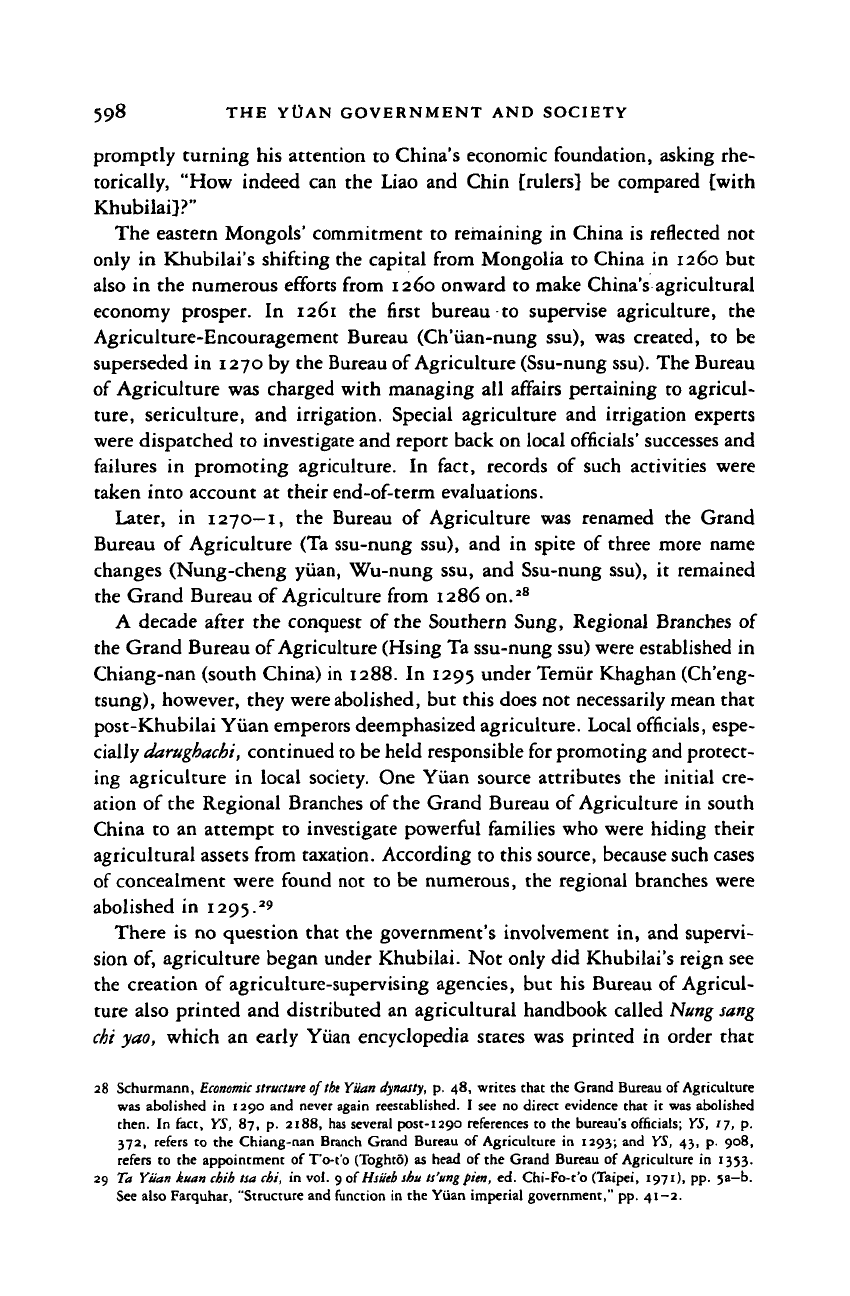
598 THE YOAN GOVERNMENT AND SOCIETY
promptly turning his attention to China's economic foundation, asking rhe-
torically, "How indeed can the Liao and Chin [rulers] be compared [with
Khubilai]?"
The eastern Mongols' commitment to remaining in China is reflected not
only in Khubilai's shifting the capital from Mongolia to China in 1260 but
also in the numerous efforts from 1260 onward to make China's agricultural
economy prosper. In 1261 the first bureau to supervise agriculture, the
Agriculture-Encouragement Bureau (Ch'iian-nung ssu), was created, to be
superseded in 1270 by the Bureau of Agriculture (Ssu-nung ssu). The Bureau
of Agriculture was charged with managing all affairs pertaining to agricul-
ture,
sericulture, and irrigation. Special agriculture and irrigation experts
were dispatched to investigate and report back on local officials' successes and
failures in promoting agriculture. In fact, records of such activities were
taken into account at their end-of-term evaluations.
Later, in
1270-1,
the Bureau of Agriculture was renamed the Grand
Bureau of Agriculture (Ta ssu-nung ssu), and in spite of three more name
changes (Nung-cheng yuan, Wu-nung ssu, and Ssu-nung ssu), it remained
the Grand Bureau of Agriculture from 1286 on.
28
A decade after the conquest of the Southern Sung, Regional Branches of
the Grand Bureau of Agriculture (Hsing Ta ssu-nung ssu) were established in
Chiang-nan (south China) in 1288. In 1295 under Temiir Khaghan (Ch'eng-
tsung),
however, they were abolished, but this does not necessarily mean that
post-Khubilai Yuan emperors deemphasized agriculture. Local officials, espe-
cially
darugbachi,
continued to be held responsible for promoting and protect-
ing agriculture in local society. One Yuan source attributes the initial cre-
ation of the Regional Branches of the Grand Bureau of Agriculture in south
China to an attempt to investigate powerful families who were hiding their
agricultural assets from taxation. According to this source, because such cases
of concealment were found not to be numerous, the regional branches were
abolished in 1295.
29
There is no question that the government's involvement in, and supervi-
sion of, agriculture began under Khubilai. Not only did Khubilai's reign see
the creation of agriculture-supervising agencies, but his Bureau of Agricul-
ture also printed and distributed an agricultural handbook called
Nung sang
chi
yao,
which an early Yuan encyclopedia states was printed in order that
28 Schurmann,
Economic structure
ofthi Yuan dynasty, p. 48, writes that the Grand Bureau of Agriculture
was abolished in 1290 and never again reestablished. I see no direct evidence that it was abolished
then.
In fact, YS, 87, p. 2188, has several post-1290 references to the bureau's officials; YS, 17, p.
372,
refers to the Chiang-nan Branch Grand Bureau of Agriculture in 1293; and YS, 43, p. 908,
refers to the appointment of T'o-t'o (Toghto) as head of the Grand Bureau of Agriculture in 1353.
29 Ta Yuan kuan chih tsa chi, in vol. 9 of
Hsiieb
shu ts'ungpitn, ed. Chi-Fo-t'o (Taipei, 1971), pp. 5a-b.
See also Farquhar, "Structure and function in the Yiian imperial government," pp. 41-2.
Cambridge Histories Online © Cambridge University Press, 2008

GOVERNMENT 599
"the people of the empire would read its contents and acquire its skills."
30
The handbook's original preface by Wang P'an, a Han-lin academician,
admits that the Nung
sang
chi yao
was compiled from the contents of previous
agricultural handbooks; in other words, the book's information about agricul-
tural techniques was not new. Rather, the purpose of the handbook, accord-
ing to Wang P'an, was to educate government agricultural officials.3'
In addition to its publishing effort, the Yuan government in the early
1270s established agricultural communities
{she),
utilizing an earlier form of
local social organization. The unsalaried appointees of the
she
were to encour-
age agricultural production, maintain charity granaries (i-ts'ang), supervise
taxation and corvee obligations, and set the proper moral tone in their units.
The
she
unit itself was to consist of fifty households, but whether these units
were in fact superimposed on all of China's villages in the thirteenth century
is open to question. The creation of a state institution in local society is,
however, entirely consistent with Khubilai's thirty-four-year effort to revital-
ize the Chinese economy after decades of watfare.
The Directorate of Waterways, like the Grand Bureau of Agriculture, was
a specialized civilian agency, charged with overseeing canals, dikes, irriga-
tion systems, bridges, and locks.
32
First instituted in 1291, the Directorate
of Waterways was given jurisdiction over the Waterways Supervisorate (Ho
tao t'i-chii ssu) in 1292, thus centralizing all matters concerning interior
waterways. Not surprisingly, the government established Branch (Hsing-)
Directorates of Waterways to manage local problems and natural disasters.
Similar to the Grand Bureau of Agriculture and the Directorate of Water-
ways were those agencies set up to regulate maritime trade and, in particular,
to regulate the activities of the ortogh (Muslim partnership) merchants.
33
Before the Mongols conquered south China, no such supervisory agencies had
been established. It was only during Khubilai's reign that the Yuan govern-
ment, in order to encourage foreign trade and thereby profit from it through
maritime trade taxes, reestablished the Maritime Trade Bureau (Shih-po ssu).
In doing so, the Yuan followed Sung precedent. The Sung in 1087 had set up
a Maritime Trade Bureau in Ch'iian-chou, an important port city on the
Fukien coast, and the Yuan established its first bureau there in 1277. The
number of Maritime Trade Bureaus rose to seven by 1293, as Khubilai's
30 Ch'en Yiian-ching, comp., Shih
lin
kuang
chi
(Chien-an, 1330—3; repr. Peking, 1963),
12, p. ia.
31
Nung sang chi yao(SPPY ed.), p. ia.
32 Y5, 90, pp. 2295—6; Ratchnevsky, Un
code
des
Yuan, vol. 1, p. 267, no. 2; Hucker, A dictionary of
official
titles in imperial China, p. 542; and Farquhar, "Structure and function in the Yuan imperial
government," pp. 42-3.
33 On maritime trade, see Schurmann,
Economic structure
of the Yuan dynasty, pp. 222-36. Sources on the
ortogh merchants and attempts to regulate their activities are cited in Elizabeth Endicott-West,
"Merchant associations in Yuan China: The
ortogh,"
Asia
Major,
3rd. series, vol. 2, pt. 2 (1989), pp.
127-54-
Cambridge Histories Online © Cambridge University Press, 2008
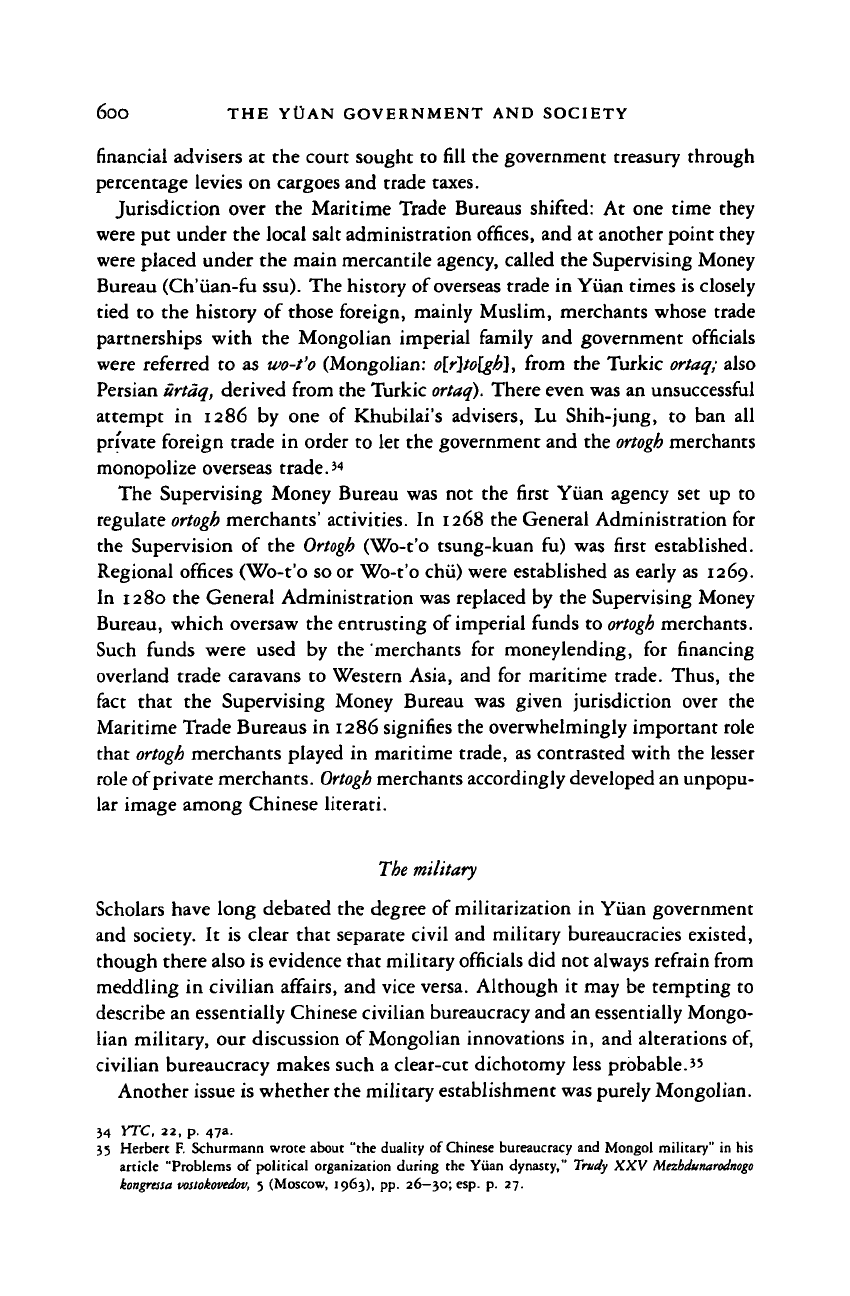
600 THE YOAN GOVERNMENT AND SOCIETY
financial advisers
at the
court sought
to
fill
the
government treasury through
percentage levies
on
cargoes
and
trade taxes.
Jurisdiction over
the
Maritime Trade Bureaus shifted:
At one
time they
were
put
under
the
local salt administration offices,
and at
another point they
were placed under
the
main mercantile agency, called
the
Supervising Money
Bureau (Ch'iian-fu ssu). The history
of
overseas
trade
in
Yuan times is closely
tied
to the
history
of
those foreign, mainly Muslim, merchants whose trade
partnerships with
the
Mongolian imperial family
and
government officials
were referred
to as
wo-t'o
(Mongolian:
o[r]to[gh],
from
the
Turkic
ortaq;
also
Persian
iirtaq,
derived from the Turkic
ortaq).
There even was
an
unsuccessful
attempt
in 1286 by one of
Khubilai's advisers,
Lu
Shih-jung,
to ban all
private foreign trade
in
order
to let the
government
and the
ortogh
merchants
monopolize overseas trade.
34
The Supervising Money Bureau
was not the
first Yuan agency
set up to
regulate
ortogh
merchants' activities.
In
1268
the
General Administration
for
the Supervision
of the
Ortogh
(Wo-t'o tsung-kuan
fu) was
first established.
Regional offices (Wo-t'o so
or
Wo-t'o chii) were established
as
early
as 1269.
In
1280 the
General Administration was replaced
by the
Supervising Money
Bureau, which oversaw
the
entrusting
of
imperial funds
to
ortogh
merchants.
Such funds were used
by the
'merchants
for
moneylending,
for
financing
overland trade caravans
to
Western Asia,
and for
maritime trade. Thus,
the
fact that
the
Supervising Money Bureau
was
given jurisdiction over
the
Maritime Trade Bureaus
in
1286 signifies the overwhelmingly important role
that
ortogh
merchants played
in
maritime trade,
as
contrasted with
the
lesser
role of private merchants.
Ortogh
merchants accordingly developed an unpopu-
lar image among Chinese literati.
The military
Scholars have long debated
the
degree
of
militarization
in
Yuan government
and society.
It is
clear that separate civil
and
military bureaucracies existed,
though there also is evidence that military officials
did
not always refrain from
meddling
in
civilian affairs,
and
vice versa. Although
it may be
tempting
to
describe an essentially Chinese civilian bureaucracy and
an
essentially Mongo-
lian military,
our
discussion
of
Mongolian innovations
in, and
alterations
of,
civilian bureaucracy makes such a clear-cut dichotomy less probable.
35
Another issue
is
whether the military establishment was purely Mongolian.
34
YTC,
22, p. 47a.
35
Herberc
F.
Schurmann
wrote
about
"the
duality
of
Chinese
bureaucracy
and
Mongol
military"
in his
article
"Problems
of
political
organization
during
the
Yuan
dynasty,"
Trudy
XXV
Mezhdunarodnogo
kongrtssa
vostokovedov,
5
(Moscow,
1963),
pp.
26—30;
esp.
p. 27.
Cambridge Histories Online © Cambridge University Press, 2008
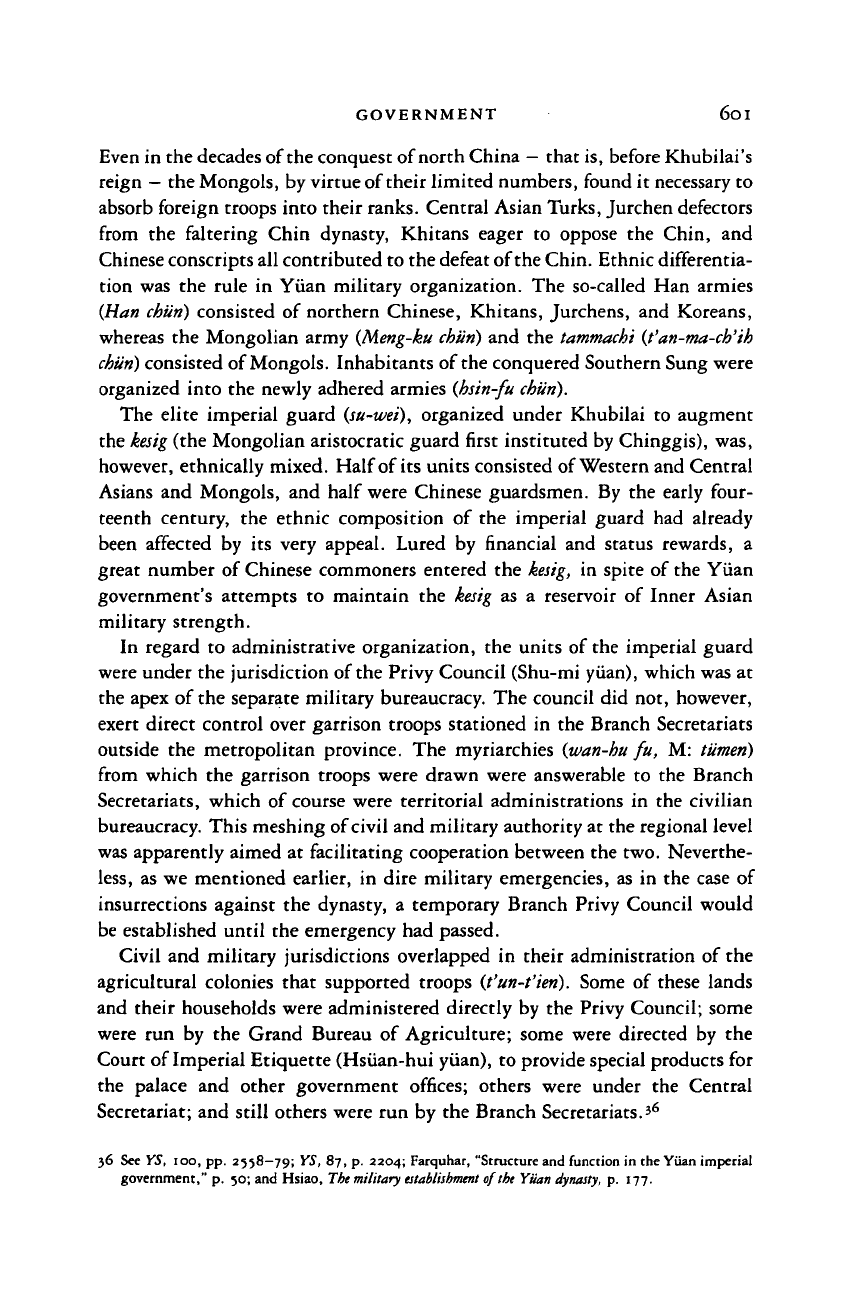
GOVERNMENT
6oi
Even in the decades of the conquest of north China
—
that is, before Khubilai's
reign
—
the Mongols, by virtue of their limited numbers, found it necessary to
absorb foreign troops into their ranks. Central Asian Turks, Jurchen defectors
from the faltering Chin dynasty, Khitans eager to oppose the Chin, and
Chinese conscripts all contributed to the defeat of the Chin. Ethnic differentia-
tion was the rule in Yuan military organization. The so-called Han armies
(Han chiin) consisted of northern Chinese, Khitans, Jurchens, and Koreans,
whereas the Mongolian army (Meng-ku
chiin)
and the tammachi (t'an-ma-ch'ih
chiin)
consisted of
Mongols.
Inhabitants of the conquered Southern Sung were
organized into the newly adhered armies (hsin-fu chiin).
The elite imperial guard (su-wei), organized under Khubilai to augment
the
kesig
(the Mongolian aristocratic guard first instituted by Chinggis), was,
however, ethnically mixed. Half of its units consisted of Western and Central
Asians and Mongols, and half were Chinese guardsmen. By the early four-
teenth century, the ethnic composition of the imperial guard had already
been affected by its very appeal. Lured by financial and status rewards, a
great number of Chinese commoners entered the kesig, in spite of the Yuan
government's attempts to maintain the kesig as a reservoir of Inner Asian
military strength.
In regard to administrative organization, the units of the imperial guard
were under the jurisdiction of the Privy Council (Shu-mi yuan), which was at
the apex of the separate military bureaucracy. The council did not, however,
exert direct control over garrison troops stationed in the Branch Secretariats
outside the metropolitan province. The myriarchies (wan-hu fu, M: ttimeri)
from which the garrison troops were drawn were answerable to the Branch
Secretariats, which of course were territorial administrations in the civilian
bureaucracy. This meshing of civil and military authority at the regional level
was apparently aimed at facilitating cooperation between the two. Neverthe-
less,
as we mentioned earlier, in dire military emergencies, as in the case of
insurrections against the dynasty, a temporary Branch Privy Council would
be established until the emergency had passed.
Civil and military jurisdictions overlapped in their administration of the
agricultural colonies that supported troops (t'un-t'ien). Some of these lands
and their households were administered directly by the Privy Council; some
were run by the Grand Bureau of Agriculture; some were directed by the
Court of Imperial Etiquette (Hsiian-hui yuan), to provide special products for
the palace and other government offices; others were under the Central
Secretariat; and still others were run by the Branch Secretariats.
36
36 See YS, 100, pp. 2558-79; YS, 87, p. 2204; Farquhar, "Structure and function in the Yuan imperial
government," p. 50; and Hsiao, The military
establishment
of the Yuan dynasty, p. 177.
Cambridge Histories Online © Cambridge University Press, 2008
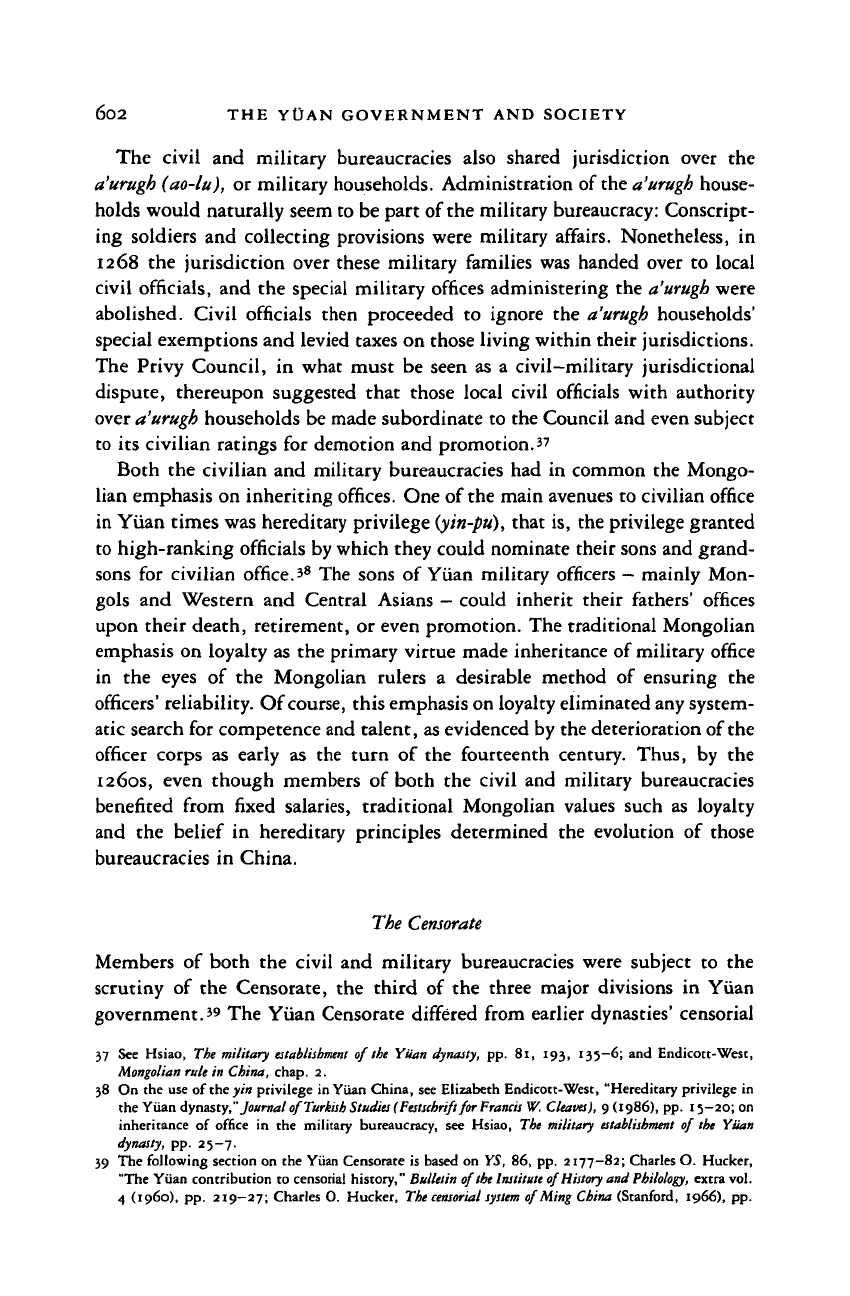
602 THE YOAN GOVERNMENT AND SOCIETY
The civil and military bureaucracies also shared jurisdiction over the
a'urugh
(ao-lu),
or military households. Administration of the
a'urugh
house-
holds would naturally seem to be part of the military bureaucracy: Conscript-
ing soldiers and collecting provisions were military affairs. Nonetheless, in
1268 the jurisdiction over these military families was handed over to local
civil officials, and the special military offices administering the
a'urugh
were
abolished. Civil officials then proceeded to ignore the
a'urugh
households'
special exemptions and levied taxes on those living within their jurisdictions.
The Privy Council, in what must be seen as a civil-military jurisdictional
dispute, thereupon suggested that those local civil officials with authority
over
a'urugh
households be made subordinate to the Council and even subject
to its civilian ratings for demotion and promotion.
37
Both the civilian and military bureaucracies had in common the Mongo-
lian emphasis on inheriting offices. One of the main avenues to civilian office
in Yuan times was hereditary privilege
(yin-pu),
that is, the privilege granted
to high-ranking officials by which they could nominate their sons and grand-
sons for civilian office.
38
The sons of Yuan military officers - mainly Mon-
gols and Western and Central Asians
—
could inherit their fathers' offices
upon their death, retirement, or even promotion. The traditional Mongolian
emphasis on loyalty as the primary virtue made inheritance of military office
in the eyes of the Mongolian rulers a desirable method of ensuring the
officers' reliability. Of course, this emphasis on loyalty eliminated any system-
atic search for competence and talent, as evidenced by the deterioration of the
officer corps as early as the turn of the fourteenth century. Thus, by the
1260s, even though members of both the civil and military bureaucracies
benefited from fixed salaries, traditional Mongolian values such as loyalty
and the belief in hereditary principles determined the evolution of those
bureaucracies in China.
The Censorate
Members of both the civil and military bureaucracies were subject to the
scrutiny of the Censorate, the third of the three major divisions in Yuan
government.
39
The Yuan Censorate differed from earlier dynasties' censorial
37 See Hsiao, The military
establishment
of the Ytian dynasty, pp. 8i, 193, 135-6; and Endicott-West,
Mongolian rule in China, chap. 2.
38 On the use of the yin privilege in Yuan China, see Elizabeth Endicott-West, "Hereditary privilege in
the Yuan dynasty,"Journal of
Turkish
Studies (Festschrift for
Francis
W. Cleaves), 9 (1986), pp. 15-20; on
inheritance of office in the military bureaucracy, see Hsiao, The military
establishment
of the Yuan
dynasty, pp. 25-7.
39 The following section on the Yuan Censorate is based on YS, 86, pp. 2177-82; Charles O. Hucker,
"The Yuan contribution to censorial history," Bulletin of the Institute of History and
Philology,
extra vol.
4 (i960), pp. 219—27; Charles 0. Hucker, The
censorial system
of Ming China (Stanford, 1966), pp.
Cambridge Histories Online © Cambridge University Press, 2008
